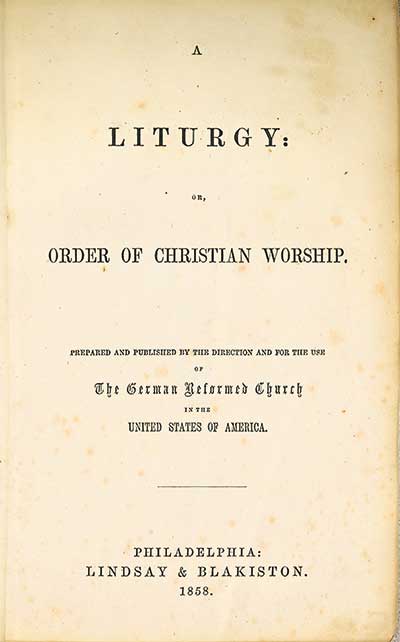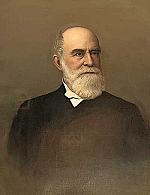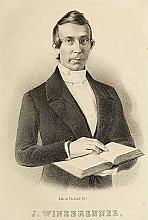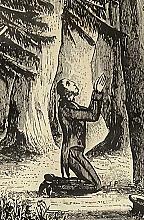Mystic, sweet Communion

[German Reformed Church in the United States of America, A Liturgy, or, Order of Christian Worship, 1858—Public domain, Lancaster Theological Seminary Digital Archive]
The whole Congregation now rising [after confession], the Minister shall proceed:
The Lord be with you.
And with thy spirit.
Lift up your hearts.
We lift them up unto the Lord.
Let us give thanks unto the Lord our God.
It is meet and right so to do.
It is very meet, right, and our bounden duty, that we should at all times, and in all places, give thanks unto Thee, Lord God Almighty, Father, Son, and Holy Ghost. Before the mountains were brought forth, or ever Thou hadst formed the earth and the world, even from everlasting to everlasting, Thou art God. Thou didst in the beginning create all things for Thyself. By Thy word were the heavens made, and all the host of them by the breath of Thy mouth. The armies of the invisible world, angels and archangels, thrones, dominions, principalities and powers; the glorious firmament on high, sun, moon, and stars; the earth and the fullness thereof; all are the work of Thy hands, and all are upheld by Thee continually in their being, as they stand by Thee, likewise, in their appointed order and course.
[The prayer describes the creation, fall, and redemption of humanity, and offers praise to the Trinity.]
Thee, mighty God, heavenly King, we magnify and praise. With patriarchs and prophets, apostles and martyrs; with the holy Church throughout all the world; with the heavenly Jerusalem, the joyful assembly and congregation of the first-born on high; with the innumerable company of angels round about Thy throne, the heaven of heavens, and all the powers therein; we worship and adore Thy glorious name, joining in the song of the Cherubim and Seraphim, and with united voice, saying:
Here let the people join aloud in the Seraphic Hymn.
Holy, Holy, Holy, Lord God of Sabaoth; heaven and earth are full of the majesty of Thy glory. Hosanna in the highest! Blessed is He that cometh in the name of the Lord. Hosanna in the highest!
Then the Minister shall proceed:
[Here the Words of Institution are given, in all capitals, with instructions for the minister to take and break the bread and to take and display the cup.]
Let us pray.
ALMIGHTY God, our heavenly Father, send down, we beseech Thee, the powerful benediction of thy Holy Spirit upon these elements of bread and wine, that being set apart now from a common to a sacred and mystical use, they may exhibit and represent to us with true effect the Body and Blood of Thy Son, Jesus Christ; so that in the use of them we may be made, through the power of the Holy Ghost, to partake really and truly of His blessed life, whereby only we can be saved from death, and raised to immortality at the last day.
Amen.
[The prayer continues that God will accept the “memorial of the blessed sacrifice of Thy Son,” not through the merits of the worshipers but through the merits of Christ; and then a prayer consecrating the worshipers “on the altar of the gospel.” Then follows an entire litany of prayers for the church and the world.]
Here let the people join aloud in the Lord’s Prayer.
[Text given. The minister then gives a lengthy blessing.]
Here the Holy Communion shall take place.
[Instructions are given for Communion.]
When all have communicated, the Minister shall offer a free Prayer, or the Post-Communion Prayer may be said:
[An optional post-Communion prayer is given.]
Then shall be sung or said the Te Deum, unless it may have been used in the first part of the service; in which case it will be proper to use instead of it here, the Gloria in Excelsis, or a part of the 103rd Psalm. After which the Minister shall pronounce. . . this Benediction:
[A benediction drawn from Philippians 4:7 is given.]
—from A Liturgy: Order of Christian Worship by The German Reformed Church in the United States of America (1857)
By German Reformed Church in the United States of America
[Christian History originally published this article in Christian History Issue #155 in 2025]
Next articles
Centering Jesus
Emanuel Vogel Gerhart, a student of Mercersburg, became one of its key advancers
Annette G. AubertPerspectives on Mercersburg
A theological roundtable
Jennifer Woodruff Tait, William B. Evans, John H. Armstrong, and the editorsRecommended resources: Mercersburg movement
Learn more about the Mercersburg movement’s main figures, critics, influences, and legacy with these recommendations from Christian History’s authors and editors.
the authors and editorsSupport us
Christian History Institute (CHI) is a non-profit Pennsylvania corporation founded in 1982. Your donations support the continuation of this ministry
Donate







